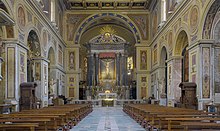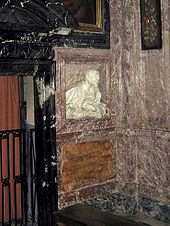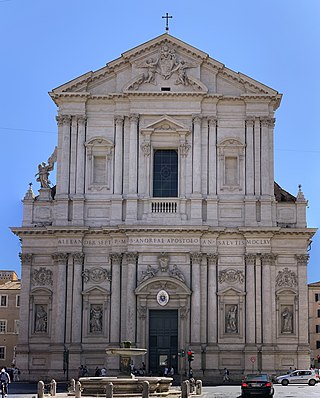
Sant'Andrea della Valle is a minor basilica in the rione of Sant'Eustachio of the city of Rome, Italy. The basilica is the general seat for the religious order of the Theatines. It is located at Piazza Vidoni, at the intersection of Corso Vittorio Emanuele and Corso Rinascimento.

The Latin Patriarchate of Alexandria was a nominal patriarchate of the Latin church on the see of Alexandria in Egypt.

As the home of the Pope and the Catholic curia, as well as the locus of many sites and relics of veneration related to apostles, saints and Christian martyrs, Rome had long been a destination for pilgrims. The Via Francigena was an ancient pilgrim route between England and Rome. It was customary to end the pilgrimage with a visit to the tombs of Saints Peter and Paul. Periodically, some were moved to travel to Rome for the spiritual benefits accrued during a Jubilee. These indulgences sometimes required a visit to a specific church or churches. Pilgrims need not visit each church.

There are more than 900 churches in Rome, which makes it the city with the largest number of churches in the world. Almost all of these are Catholic.

Santa Cecilia in Trastevere is a 5th-century church in Rome, Italy, in the Trastevere rione, devoted to the Roman martyr Saint Cecilia.

San Marcello al Corso, a church in Rome, Italy, is a cardinalitial titular church whose cardinal-protector is normally of the order of cardinal priests.

San Marco is a minor basilica in Rome dedicated to Saint Mark the Evangelist located in the small Piazza di San Marco adjoining Piazza Venezia. It was first built in 336 by Pope Mark, whose remains are in an urn located below the main altar. The basilica is the national church of Venice in Rome.

The Minor Basilica of St. Lawrence in Damaso or simply San Lorenzo in Damaso is a parish and titular church in central Rome, Italy that is dedicated to St. Lawrence, deacon and martyr. It is incorporated into the Palazzo della Cancelleria, which enjoys the extraterritoriality of the Holy See.
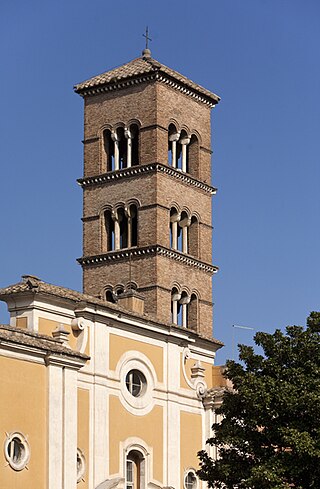
The Basilica of San Sisto Vecchio is one of the over sixty minor basilicas among the churches of Rome, and a titular church since 600 AD. As such, it is connected to the title of a Cardinal priest, currently Antoine Kambanda.
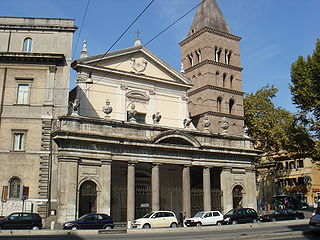
San Crisogono is a church in Rome dedicated to the martyr Saint Chrysogonus. It was one of the tituli, the first parish churches of Rome, and was probably built in the 4th century under Pope Sylvester I (314–335).

The church of San Lorenzo in Panisperna is a Roman Catholic church on Via Panisperna, Rome, central Italy. It was previously known as "San Lorenzo in Formoso". It was erected on the site of its dedicatee's martyrdom. It is one of several churches in Rome dedicated to him.

The Diocese of Città di Castello is a Latin diocese of the Catholic Church in the ecclesiastical province of the metropolitan Archdiocese of Perugia-Città della Pieve, in the central Italian region of Umbria.
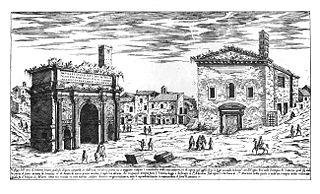
Sant'Adriano al Foro was a church in Rome, formerly in the Curia Julia in the Forum Romanum and a cardinal-deaconry.
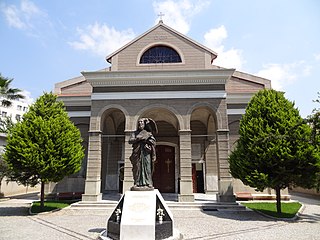
The Roman Catholic Metropolitan Archdiocese of İzmir is a Latin archdiocese of the Roman Catholic Church in Asian Turkey (Anatolia).

The Diocese of San Marino-Montefeltro is a Latin Church ecclesiastical jurisdiction or diocese of the Catholic Church in both Italy and San Marino. It is a suffragan in the ecclesiastical province of the metropolitan Archdiocese of Ravenna-Cervia. The current diocese includes all the parishes of San Marino.
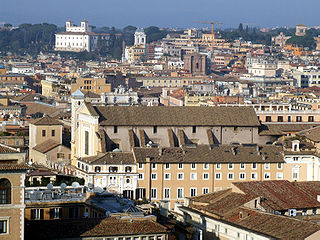
Santi Dodici Apostoli, commonly known simply as Santi Apostoli, is a 6th-century Roman Catholic parish and titular church and minor basilica in Rome, Italy, dedicated originally to St. James and St. Philip, whose remains are kept here, and later to all Apostles. Today, the basilica is under the care of the Conventual Franciscans, whose headquarters in Rome is in the adjacent building. It is the Station church for Friday, the first week of Lent.
The Diocese of Belcastro in the town of Belcastro in the province of Catanzaro, in the Calabria region of southern Italy. In 1828, it was suppressed to the Archdiocese of Santa Severina.

The Diocese of Famagusta was a Latin Church ecclesiastical jurisdiction or diocese of the Catholic Church. Its episcopal see was the city of Famagusta, on the island of Cyprus during crusader rule, and is now a Latin Catholic titular see.
The Diocese of Novigrad was a Latin Church ecclesiastical jurisdiction or diocese of the Catholic Church located in the city of Novigrad, Istria, Croatia until it was suppressed to the Diocese of Trieste in 1831.
The Roman Catholic Diocese of Civita(-Tempio) was a Latin Catholic bishopric in the Gallura region of northern Sardinia.


